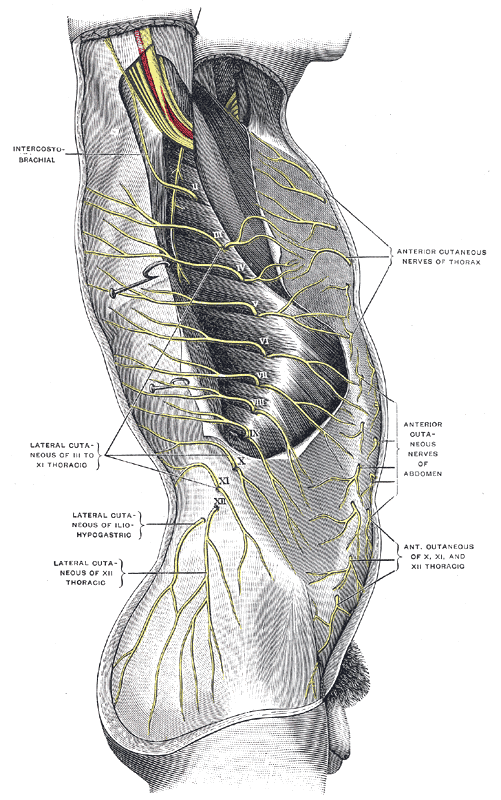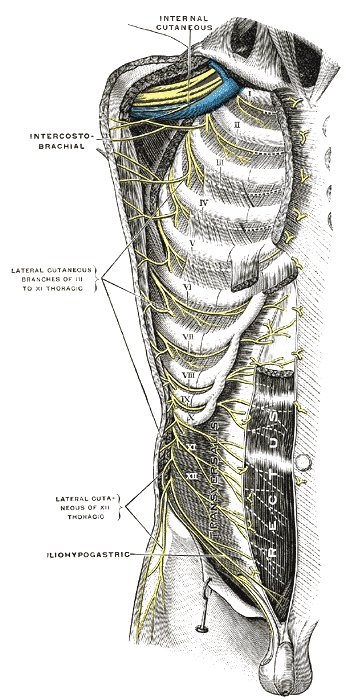[1]
Henry BM, Graves MJ, Pękala JR, Sanna B, Hsieh WC, Tubbs RS, Walocha JA, Tomaszewski KA. Origin, Branching, and Communications of the Intercostobrachial Nerve: a Meta-Analysis with Implications for Mastectomy and Axillary Lymph Node Dissection in Breast Cancer. Cureus. 2017 Mar 17:9(3):e1101. doi: 10.7759/cureus.1101. Epub 2017 Mar 17
[PubMed PMID: 28428928]
Level 1 (high-level) evidence
[2]
Loukas M, Hullett J, Louis RG Jr, Holdman S, Holdman D. The gross anatomy of the extrathoracic course of the intercostobrachial nerve. Clinical anatomy (New York, N.Y.). 2006 Mar:19(2):106-11
[PubMed PMID: 16470542]
[3]
Kasai T, Yamamoto N. [Medial brachial cutaneous nerves and the intercostobrachial nerves]. Kaibogaku zasshi. Journal of anatomy. 1966 Feb 1:41(1):29-42
[PubMed PMID: 6006530]
[4]
Andersen KG, Duriaud HM, Aasvang EK, Kehlet H. Association between sensory dysfunction and pain 1 week after breast cancer surgery: a psychophysical study. Acta anaesthesiologica Scandinavica. 2016 Feb:60(2):259-69. doi: 10.1111/aas.12641. Epub 2015 Oct 8
[PubMed PMID: 26446738]
[5]
van Tonder DJ, Lorke DE, Nyirenda T, Keough N. An uncommon, unilateral motor variation of the intercostobrachial nerve. Morphologie : bulletin de l'Association des anatomistes. 2022 Sep:106(354):209-213. doi: 10.1016/j.morpho.2021.06.003. Epub 2021 Jun 25
[PubMed PMID: 34183262]
[6]
Chirappapha P, Arunnart M, Lertsithichai P, Supsamutchai C, Sukarayothin T, Leesombatpaiboon M. Evaluation the effect of preserving intercostobrachial nerve in axillary dissection for breast cancer patient. Gland surgery. 2019 Dec:8(6):599-608. doi: 10.21037/gs.2019.10.06. Epub
[PubMed PMID: 32042666]
[7]
Shah AN, Metzger O, Bartlett CH, Liu Y, Huang X, Cristofanilli M. Hormone Receptor-Positive/Human Epidermal Growth Receptor 2-Negative Metastatic Breast Cancer in Young Women: Emerging Data in the Era of Molecularly Targeted Agents. The oncologist. 2020 Jun:25(6):e900-e908. doi: 10.1634/theoncologist.2019-0729. Epub 2020 Mar 16
[PubMed PMID: 32176406]
[8]
Urits I, Lavin C, Patel M, Maganty N, Jacobson X, Ngo AL, Urman RD, Kaye AD, Viswanath O. Chronic Pain Following Cosmetic Breast Surgery: A Comprehensive Review. Pain and therapy. 2020 Jun:9(1):71-82. doi: 10.1007/s40122-020-00150-y. Epub 2020 Jan 28
[PubMed PMID: 31994018]
[9]
Beyaz SG, Ergönenç JŞ, Ergönenç T, Sönmez ÖU, Erkorkmaz Ü, Altintoprak F. Postmastectomy Pain: A Cross-sectional Study of Prevalence, Pain Characteristics, and Effects on Quality of Life. Chinese medical journal. 2016 Jan 5:129(1):66-71. doi: 10.4103/0366-6999.172589. Epub
[PubMed PMID: 26712435]
Level 2 (mid-level) evidence
[10]
Wijayasinghe N, Duriaud HM, Kehlet H, Andersen KG. Ultrasound Guided Intercostobrachial Nerve Blockade in Patients with Persistent Pain after Breast Cancer Surgery: A Pilot Study. Pain physician. 2016 Feb:19(2):E309-18
[PubMed PMID: 26815258]
Level 3 (low-level) evidence
[11]
Saleh Z, Salleron J, Baffert S, Paveau A, Classe JM, Marchal F. [Impact of the preservation of the branches of intercostobrachial nerve on the quality of life of patients operated for a breast cancer]. Bulletin du cancer. 2017 Oct:104(10):858-868. doi: 10.1016/j.bulcan.2017.08.002. Epub 2017 Sep 14
[PubMed PMID: 28917551]
Level 2 (mid-level) evidence
[12]
Orsolya HB, Coros MF, Stolnicu S, Naznean A, Georgescu R. Does the Surgical Management of the Intercostobrachial Nerve Influence the Postoperatory Paresthesia of the Upper Limb and Life Quality in Breast Cancer Patients? Chirurgia (Bucharest, Romania : 1990). 2017 Jul-Aug:112(4):436-442. doi: 10.21614/chirurgia.112.4.436. Epub
[PubMed PMID: 28862120]
Level 2 (mid-level) evidence
[13]
Varela V, Ruíz C, Pomés J, Pomés I, Montecinos S, Sala-Blanch X. Usefulness of high-resolution ultrasound for small nerve blocks: visualization of intercostobrachial and medial brachial cutaneous nerves in the axillary area. Regional anesthesia and pain medicine. 2019 Aug 26:():. pii: rapm-2019-100689. doi: 10.1136/rapm-2019-100689. Epub 2019 Aug 26
[PubMed PMID: 31451625]


